SHE Management
Management coexisting with the environment
We create a zero-harm, eco-friendly workplace based on strict company guidelines and preventive systems.
Environment, health, and safety management policy
To achieve sustainable corporate development and fulfill social responsibilities,  acknowledges environment, health, and safety as n inherent values of corporate management and makes the following efforts.
acknowledges environment, health, and safety as n inherent values of corporate management and makes the following efforts.
- 01 Environment, Health, and Safety prioritized management We eliminate risk factors and minimize risks considering environment, health, and safety as the top priority goals of management.
- 02 Creating safe work environment We strive to create a safety culture and a safe work environment that involves all executives and employees.
- 03 Complying with environment and safety regulations We voluntarily comply with rules and regulations and seek continuous activities for improvement.
- 04 Responding to climate change We contribute towards the conservation of the global environment by minimizing pollutant emissions and reducing greenhouse gases.
CEO In-Hwan Kim
Safety/health management
- Structured system operation
- Based on the PDCA Cycle required by the occupational health and safety management system (ISO 45001), we systematically implement the system and practice health and safety management through constant improvement, while also carrying out activities to handle the risk factors in the processes that may lead to severe industrial accidents such as fire, explosion, and leakage.
-
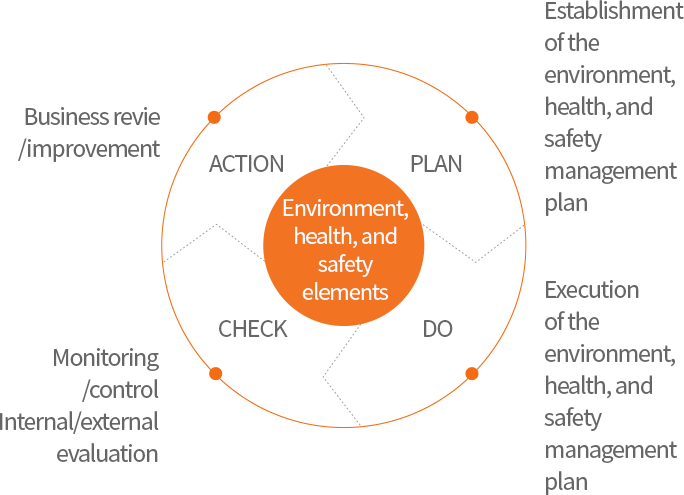
Environment, health, and safety elements
- PLAN
- Establishment of the environment, health, and safety management plan
- DO
- Execution of the environment, health, and safety management plan
- CHECK
- Monitoring/control
Internal/external evaluation - ACTION
- Business review/improvement
- Participatory safety culture
- We strive to promote safety communication by regularly conducting safety inspections and safety meetings that are led by the management and involve both labor and management. Furthermore, by continuously finding and eliminating risk factors on-site, all employees are participating in creating a safe workplace.
-
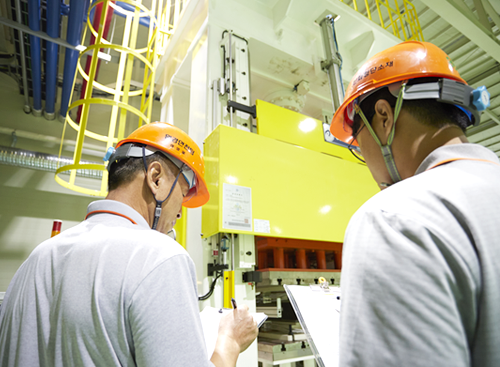
- Safety risk management
- We are constantly finding potential harmful risk factors through risk assessments and minimizing risks by establishing improvement measures. Moreover, we strive to voluntarily comply with laws and regulations by regularly evaluating and inspecting compliance with health and safety rules.
- Promotion of employee health
- Healthcare programs are implemented so that not only all employees but also all of their family members can live a healthy and safe life.
Employee healthcare programs
- Management of cerebrovascular and cardiovascular diseases, and basic illnesses
- Stretching, smoking cessation, and sobriety programs
Actions on Climate change
Towards achieving carbon neutrality
 has established mid- to long-term greenhouse gas reduction goals and is conducting relevant activities to achieve carbon neutrality by 2050.
has established mid- to long-term greenhouse gas reduction goals and is conducting relevant activities to achieve carbon neutrality by 2050.
-
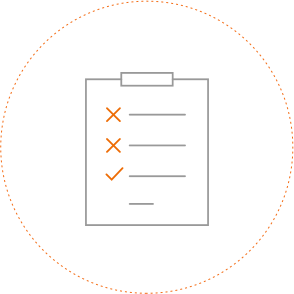
Creating multi-step roadmap
-

Purchasing renewable energy
-

Establishing an eco-friendly infrastructure
-

Promoting greenhouse gas/energy reduction activities in each business site
- Creating multi-step roadmap
- Creating a roadmap to reduce greenhouse gas emissions for each period (short-term, mid-term, long-term) by adopting reuse technology and high-efficiency facilities
- Purchasing renewable energy
- Achieving carbon neutrality by purchasing REC (Renewable Energy Certificate)
- Establishing an eco-friendly infrastructure
- Expanding an eco-friendly infrastructure by establishing energy-efficient facilities, using energy storage systems (ESS), adopting high-efficiency facilities, and adopting green vehicles
Environmental impact management
Environmental management systems and structures
- Air quality management
- We have established a policy to minimize air pollutants discharged from our business sites and are managing cumulative pollutant emissions by digitizing the data. We regularly monitor emissions by setting internal management standards that are stricter than the legal emission standards, and carry out activities to reduce pollutant emissions by preventing and blocking risk factors and improving pollutant prevention facilities.
- Water quality management
- We are managing cumulative emissions data by monitoring and analyzing wastewater in each process on yearly basis. In particular, we installed CCTVs for real-time management at the dewatering outlets for wastewater and rainwater generated on-site so that harmful substances are not discharged. Wastewater is treated internally and then ultimately treated at a public wastewater treatment facility in the industrial complex, thereby maintaining river water quality and the ecosystem and promoting environmental conservation.
- Waste management
- We consistently report on performance in relation to waste laws, policies, and systems, and we are transparently managing and disclosing the entire process of waste discharge, transport, and final disposal in real-time. We are also striving to increase the rate of waste recycling in our business sites by constantly discovering companies that can recycle waste.
- Chemical management
-
Improving the chemical management system
We have created a database of information on all chemicals handled at each business site through the corporate chemical management system (CMS) to improve system-based regulatory response and established an advanced system for chemical information management.
Chemical management process
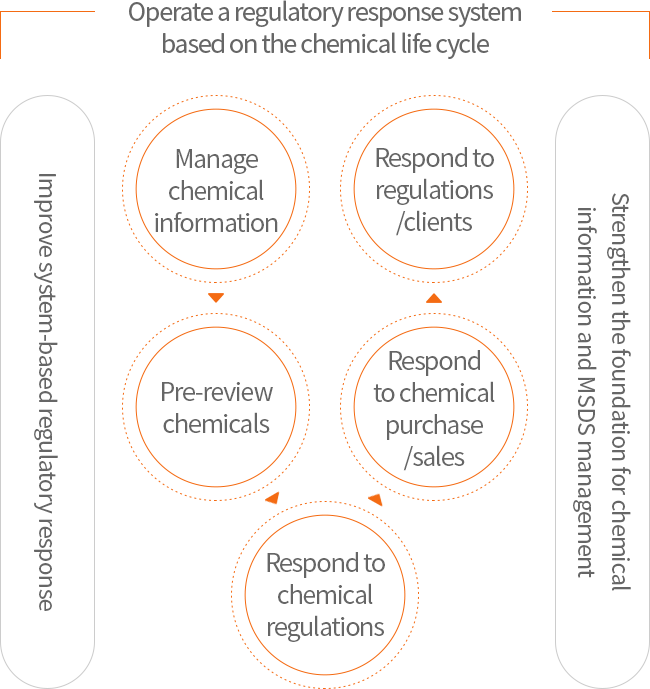 Operate a regulatory response system based on the chemical life cycle
Operate a regulatory response system based on the chemical life cycle- Manage chemical information
- Pre-review chemicals
- Respond to chemical regulations
- Respond to chemical purchase/sales
- Respond to regulations/clients
- Improve system-based regulatory response
- Strengthen the foundation for chemical information and MSDS management
Cumulative management of
chemicals using the DT system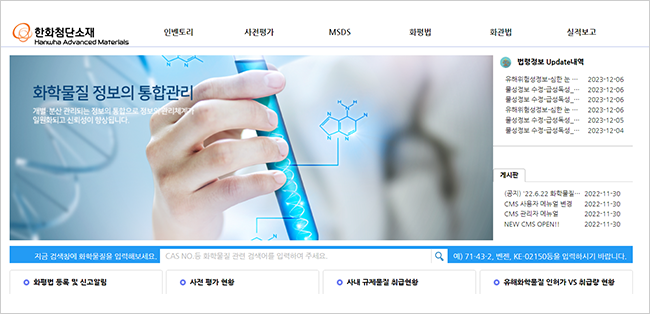
Implementation of a system that
blocks incoming chemicals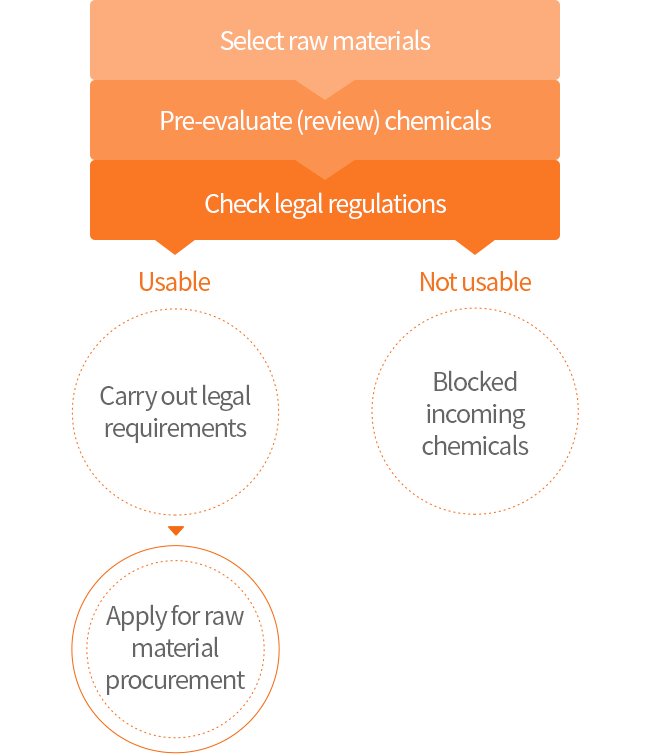
- Select raw materials
- Pre-evaluate (review) chemicals
- Check legal regulations
- Not usable
- Blocked incoming chemicals
- Usable
- Carry out legal requirements
- Apply for raw material procurement

